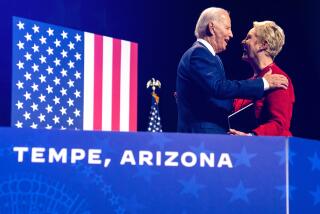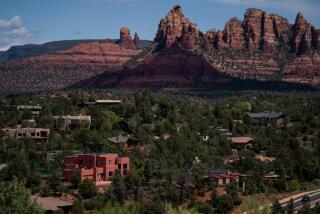Seventh-inning stretch in Mesa, Ariz.
What does Forbes know?
Not quite enough — at least, when it comes to Mesa. In December 2008, the magazine counted how often each of America’s 100 largest cities was cited in nine East Coast-based national publications and declared that the 10 least-mentioned cities were thus the “most boring.”
Mesa, with 460,000 people, was the biggest of the most boring burgs.
Ah, but mere mention does not a mecca make.
Mesa is a bargain, not a bore. Just a few miles southeast of Phoenix, Mesa offers central Arizona sunshine, cactus blossoms and Cactus League spring training (the Chicago Cubs are Mesa-based) for considerably less than the area’s more famous precincts.
The average nightly rate at Mesa’s 10 most popular hotels was $130, based on late February figures at Tripadvisor.com. The comparable figure for Phoenix was $252, and for Scottsdale, $359. Even in the Mesa-adjacent city of Tempe (springtime home of the Angels), Tripadvisor’s “most popular” lodgings cost $167. Rates in Glendale, the Dodgers’ getaway site northwest of Phoenix, averaged $189.
I may be a bit protective; I lived here when I was one of the young and the restless. Bigger cities lured me away. But as Mesa’s Blandsville image fades, we visiting ex-Mesans are frequently surprised.
If you know where to look, you’ll find plenty of life.
That western Mesa site that introduced me to Target? It’s now Mekong Plaza, a Vietnamese dining and shopping center. Its supermarket is stocked with items that never reached the Mesa of my youth — fresh parrotfish, giant durian fruits. Nearby, the new light-rail line leaves for Phoenix, defying this region’s car-centric culture.
Mesa’s developing Asian dining district continues southward. At Best Hong Kong Dining, a cook’s net fetches a thrashing tilapia out of a tank. The braised fish arrives at the table within seven minutes. Here, it’s easy to forget that Mesa is in a desert.
Driving east, I pass such urban signposts as Cup o’ Karma coffeehouse and the “Phoenix” version of the National Comedy Theatre improv chain. And then there’s Campeones (Spanish for “champions”), another transformed big-box store, now a restaurant/dance club/boxing museum/shrine to Mexican boxer Julio César Chávez. Its developers aim to attract the 200,000 Latinos who live within five miles.
Of course, the desert is the first priority of many Mesa visitors, especially during spring. They should try Saguaro Lake Ranch, the area’s most distinctive lodging. Giant saguaros and fan-like ocotillos fill the hills behind this rustic inn. Stables and trails offer riding and hiking.
Yet water is a component here, too. Some cabins are on the banks of the Salt River, where kayaking is available. Just upstream, Saguaro Lake stretches out from Stewart Mountain Dam, creating opportunities to fish, boat and water-ski. Downstream, towering cliffs — informally known as the Bulldogs — hover over the river.
The ranch seems 100 miles from any city. Actually, it’s about 12 miles to gourmet dining in northeastern Mesa’s Las Sendas area, where the bruschetta at D’Vine Bistro & Wine Bar is mouthwatering. From there, a freeway quickly reaches the rest of Mesa.
For a desert mountain experience closer to town, I go to Usery Mountain Regional Park and hike the 3.2-mile (round-trip) Wind Cave trail up Pass Mountain, through terrain that resembles a natural botanical garden. At the top of the trail, sensational views look westward toward Mesa. A brand-new visitors center, a choice of shorter or longer trails and organized outings during winter and spring make Usery an ideal place to learn about desert life.
Two museums in downtown Mesa provide indoor opportunities for a similar dose of edu-tainment. The Arizona Museum of Natural History is packed with kid-friendly attractions: large model dinosaurs, rocks, gold panning and cell-house blocks from early prisons. The colorful Arizona Museum for Youth (ages 1-12) doesn’t look particularly western, but a friendly greeter tells me that enough people have tried to bring in their firearms that the museum provides a locker where they can be checked.
For adult culture, downtown’s boldly designed, 5-year-old Mesa Arts Center stands out. Its four theaters range from 99 to 1,500 seats. Among upcoming acts: the Moscow State Radio Symphony, blues master Keb’ Mo’, Ballet Folklórico de Mexico de Amalia Hernandez, Merle Haggard and the resident theater company, Southwest Shakespeare.
Across the center’s landscaped plaza, sophisticated exhibitions in the Mesa Contemporary Arts’ five galleries sometimes challenge the area’s generally conservative tastes. A visit during the supposedly cheerful Christmas season, for example, yielded Eileen Doktorski’s massive “Domestic Arsenal” installation, detailing how household objects have been used in domestic abuse. Free center tours are available every Wednesday, including a gratis guided tour of the galleries.
I enjoy a stroll along downtown Mesa’s Main Street, where a small farmers market and a crafts fair take place on Saturdays from October through April. The area is spruced up with pretty palo brea trees, green street lamps and a collection of lifelike sculptures on street corners — plus all-local businesses.
Like most of Mesa, downtown is becoming more diverse. One spot, Inside the Bungalow, a charming converted 1916 house, features good coffee, yoga, massages, light lunches and open-mike Wednesdays. I never tasted Thai food during my Mesa years — but now it’s on Main Street at the superb Nunthaporn’s.
Just north of downtown is Hohokam Stadium, Cubs Central for at least two more springs. The team had been considering moving its spring camp to Florida after 2011 but recently decided to stay in Mesa — pending approvals by the Legislature and voters of an $84-million proposal to build a new site that would be closer to hotels and restaurants. The current location lacks a certain … liveliness. It’s across the street from the old Mesa Cemetery.
Nevertheless, Hohokam attracts more spectators than any other Cactus League stadium (203,105 last year). An exhibition about Cactus League history at the Arizona Museum for Youth, through Nov. 7, has extended baseball fever to downtown this spring.
Allegiance to the Cubs isn’t required to enjoy Mesa. Most of the other Cactus League stadiums are nearby, also seeking your attendance. Even if you don’t like baseball, Mesans don’t care. Like spring training itself, Mesa is a low-pressure, low-cost playground. But it has a lot more places to play now than it did when I was a kid.
More to Read
Sign up for The Wild
We’ll help you find the best places to hike, bike and run, as well as the perfect silent spots for meditation and yoga.
You may occasionally receive promotional content from the Los Angeles Times.






